October 9, 2020
As the air chills and winter phantoms start to haunt the hills (rhyme!) our (mine! yours! everybodies!) tastes begin to turn away from lighter things to alight onto more serious matters. In this case, to take away the high-flaunting language, I’m try to say that brown cocktail season is upon us, or nearly so (though, admittedly, I’m all for hanging on to sunlit days a little longer, and, really, I’m happy to drink whiskey or brandy or other darker-spirited cocktails anytime, but let me go with this). Which means dust off the Scotch, bourbon, Irish, Indian, Japanese, Washington, and other whiskeys – it’s time to warm up from the inside out. Starting with one of my favorite tipples in this vein, the Scotch-y/single-malt-y Rob Roy. It’s absolutely ideal for when the temperature gauge begins to plummet, with a hearty dollop of the base spirit (Scotch, that is) combined with the herbally loveliness that is sweet/red/Italian vermouth, Angostura bitters, and a waft of lemon. Ah, what a treat, not only in my mind. The creatures see of flood and field / And those that travel on the wind (thanks Wordsworth)! For the Scotch here, I’m going with Auchentoshan 12-year-old Scotch, partially cause I had a bottle on the front of my shelves, but moreso cause its smoothness and vanilla/citrus/nutty notes go so well with our other ingredients, especially to me with Carpano Antica, which I’m using for the vermouth and which I love due to its rich, lush, herbal goodness. Dive on in! Oh, wait, before you don your face paint and start drinking, here’s one fun idea: switch Angostura bitters for Scrappy’s Orange bitters, and sip a Highland Cocktail. Or have both!
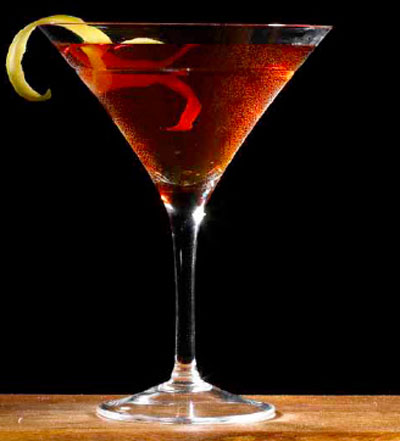
The Rob Roy
Cracked ice
2-1/2 ounces Auchentoshan 12-year-old Scotch
1/2 ounce Carpano Antica sweet vermouth
2 dashes Angostura bitters
Lemon twist, for garnish
1. Fill a cocktail shaker halfway full with cracked ice. Add the Scotch, vermouth, and bitters. Stir well.
2. Strain into a cocktail glass. Garnish with the lemon twist.
PS: The Rob Roy bar in Seattle is one of the best bars in the world, and probably even more memorable than this drink. Just wanted to make sure you knew.
Tags: Angostura bitters, Auchentoshan 12-year-old Scotch, Carpano Antica sweet vermouth, cocktail, Cocktail Recipes, Friday Night Cocktail, lemon, Scotch, sweet vermouth, The Rob Roy, What I’m Drinking
Posted in: bitters, Cocktail Recipes, Recipes, Scotch, vermouth, What I'm Drinking
October 2, 2020
Here’s a fine kettle of various ingredients mixed with booze. I had the mad/smart/odd/random/bored/inventive/normal idea not more than a couple weeks ago that I should make up a wine-based liqueur or aperitivo if you like (I like, so I’m gonna call it that), and that it should have basil in it (cause my basil plants were doing so well then, if, admittedly, not as well now as summer has dwindled), and maybe orange (cause I had an orange), and a roasted peach (which also was around and needed to be used, sans pit, but the roasting felt important), and some spices but not too many, and a hint of bitterness cause the best aperitivos (or many of them) tend to have that, and it should be pretty as that hour on a sunny late-summer day when night is nearly there, but not quite there, the hour you realize once again that summer and all things are transient, ephemeral, lovely. Whew, seems like a lot to ask of something made in a big glass jar!
But, you know, it worked out quite well. Not sure I reached the full heights I wanted, but came close-ish, to my taste, which might be different than yours. The basil is the strangest part of the equation, as it lost some of its, well, basil-ness if that makes sense. There’s not overriding basil smell or taste, or any, or very little; instead, it adds a slightly vegetal minty-ness. Interesting! The orange notes come through strong, with a little other citrus (thanks to lemon) and a dream of toasty peach, and the spice notes (tiny bits of ginger, star anise) are more inferred than active, if that makes sense. Oh, I should have started with: the wine I used as the base was an Orvieto Classico white wine, which I love, and which is dry-ish, but fruit-y-ish (more peach notes here), and grape-ish enough to bring a lot of flavor. I also added some vodka, as the wine solo didn’t seem to have enough umph for the end-of-summer delicate sadness I wanted. Sure, I’m weird! Gentian, the bittering agent of choice for so many things, underlines that thought, as well as balancing the sweetness. Really, all joshing and flighty language aside, Caducitivo (caduco in Italian meaning transient or ephemeral) was an awfully fun, and tasty, experiment, a fine pre-dinner, sipper, with a layered, light, orange-citrus-herb flavor containing a friendly bitter back end. Heck, I think I’ll make it again next year! And, with the below recipe, you can try it, too. I like sipping it at room temp, but think it’s best over ice, or chilled a bit. While I haven’t tried it yet, my guess is it’d be great with Prosecco, and also as a cocktail ingredient.
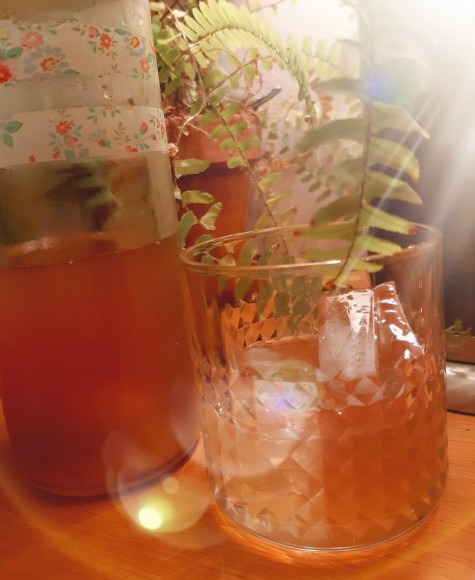 Caducitivo
Caducitivo
2 cups basil
1 roasted peach (see Note)
1 whole star anise
1/2 teaspoon ground ginger
3 wide orange twists
2 wide lemon twists
2-1/2 cups Orvieto Classico (I used Ruffino, which is nice, solid, and not overly pricey)
1/2 cup vodka (I used Prairie Organic vodka, which is swell and came in the mail)
1 cup simple syrup
1/4 teaspoon crushed gentian
1. Add the basil, peach, star anise, ginger, and citrus twists to a large glass container with a good lid. Muddle nicely. Add the wine and vodka, stir, and put that lid on it. Store in a cool dark place away from the sun. Let sit two weeks, swirling occasionally.
2. Open it back up, add the simple syrup and gentian (see Second Note), and stir well. Place it back in the cool dark place, and let sit two more weeks, swirling occasionally.
3. Strain – I went once through a decent fine strainer to get the fruit out, and then through cheesecloth to add more clarity. You might need a third straining, too.
A Note: For the peach, I just baked it at 425 F until it was slightly roasted, not charred. Also, I didn’t use the pit, just the peach itself.
A Second Note: You could add this in Step 1, but I had unexpectedly ran out, so couldn’t. And there’s something (probably nothing) in adding that bittering agent later, letting the other ingredients meet up first.
Tags: aperitivo, basil, Caducitivo, cocktail, Cocktail Recipes, Friday Night Cocktail, gentian, ginger, homemade aperitif, homemade liqueur, lemon, orange, Orvieto Classico, peach, Prairie Organic vodka, simple syrup, star anise, vodka, What I’m Drinking, white wine
Posted in: aperitif, Cocktail Recipes, Italy, Liqueurs, Recipes, vodka, What I'm Drinking, Wine
January 10, 2020
It’s funny, in a curious way, because it’s January, and January is known as a bit of a cold-hearted month for a number of reasons; one, cause it’s cold! But, the curiously funny thing is, that for the second time in two weeks, I’m having not a winter warmer, but a light, refreshing, mix with ginger beer and ice cubes and sunshine (admittedly, chilly sunshine, but sunshine, pals, is sunshine). This devilish mix, though, is such an old favorite, and (perhaps more important? I’d say most important) my wife’s top drink, or at least top five, that it gets consumed at our house – or at nearby bars – year round. It’s a treat year round, too, as the tequila smoke and warmth play so perfectly with the ginger beer, and then that unexpected in a way, slight sweet fruity boop from the cassis and tangy tang of lime (or lemon, in a pinch, hence the “esque” in this this title, but, you know, needs must), all combining into a, well, treat! No matter what the day of the year.
One note: some folks (many?) shake the tequila, juice, and cassis first. That’s not my style. I’m not saying my style is better, oh no! But I do how I do. You do you. We all can still toast drinks.
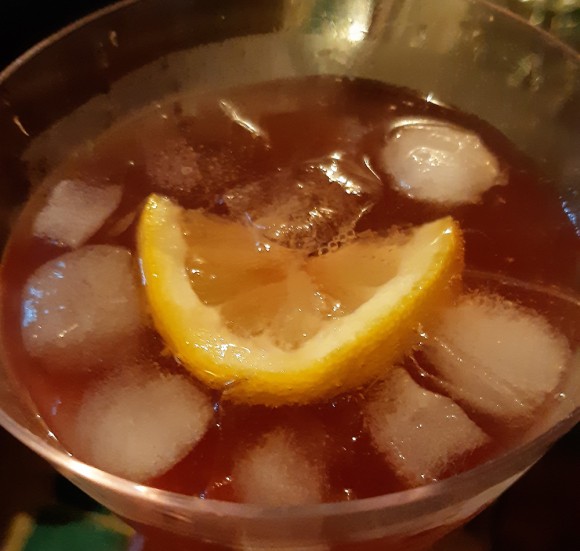
The El Diablo-esque
Ice cubes
1-1/2 ounces tequila (often, reposado, but I think blanco is nice, too)
1/2 ounce freshly squeezed lemon juice
3-1/2 ounces ginger beer
1/2 ounce crème de cassis
Lemon slice, for garnish
1. Fill a big-ish highball or comparable glass three-quarters full with ice cubes. Add the tequila, lemon juice, and ginger beer. Stir thoroughly, but no need to chase the devil in an over-rambunctious manner.
2. Carefully drizzle the cassis over-the-top of the mix (I tend to angle towards the edges, but that’s me, again). If you want, give it a brief stir. Garnish with the lemon. Go January, go!
Tags: cassis, cocktail, Cocktail Recipes, creme di cassis, Friday Night Cocktail, ginger beer, lemon, lime, Tequila, The El Diablo-esque, What I’m Drinking
Posted in: Cocktail Recipes, Liqueurs, Recipes, Tequila, What I'm Drinking
January 3, 2020
Gin. Geeeeeen. Gin. I remember when I first started making drinks with gorgeous (mostly!) gin, way way way back in the dawn of time, moreorless, a darker age in many drink ways. Back then, we only had a few gin choices, and even less choices in other boozy things. But we’re talking gin here friends, ol’ junipally gin. So, back then, again, I thought of gin in a probably more regimented fashion. But, like many (and many more each day, one hopes), I’ve learned as time has passed, and the imbibing world has changed. Jumping into our time machines (you have one, right?) from those way-back-then days of few gins to today and BOOM, gins-a-popping. All kinds of variations on the gin theme. Which leads to today, where I’m drinking a wonderful gin distilled in Italy, a gin called PiùCinque. Now, I love gin. And I love Italy. But I didn’t know that, as in many spots, Italy’s long and distinguished distilling and delicious-tipple-making scene had embraced gin, too – but it has! PiùCinque utilizes ten specific botanicals to give it a very individual taste, but one that stays true to the gin roots, with a nice even juniper-ness. One that’s partnered with nine intriguing friends (which gets us to ten, see), including I think sage, ginger root, wormwood flowers, angelica, Seville orange (if I’m reading things rightly), almond, the earthy mysterious zedoary, orris root, and lemony, springtime bergamot. That latter really brings this gin into its own, starting the taste off with light citrus notes that then smoothly move into the grounded, herbal, nut, root notes. Definitely worth a solo sipping over a cube or two.
But also, a fine ingredient for cocktails! I was sitting in some unexpectedly warm December sunshine considering gin, all the gins I’ve had, and especially this new-to-me gin, PiùCinque, and decided I wanted a refreshing mix, and something simple (cause I’m sometimes lazy, you know) and decided on an old, old friend, the Dragonfly. This basic mix of gin, ginger beer, and (usually) lime is a dandy manner to take a gin new-to-you out for a walk, so to speak. However! I only had lemons. And I was using this Italian gin for the first time! So, I changed up the name a slight bit, as one does. Anyway! The lemon actually worked a treat with this gin’s lighter, high end citrus notes, and the gin itself brought all those botanicals to the party, and, well, the drink was delicious. End of gin story! Now, I just have to figure out how to fill my suitcase when in Italy with Italian gins, so that the Italian gins can cuddly up on my gin shelf with my other gins! Gin!
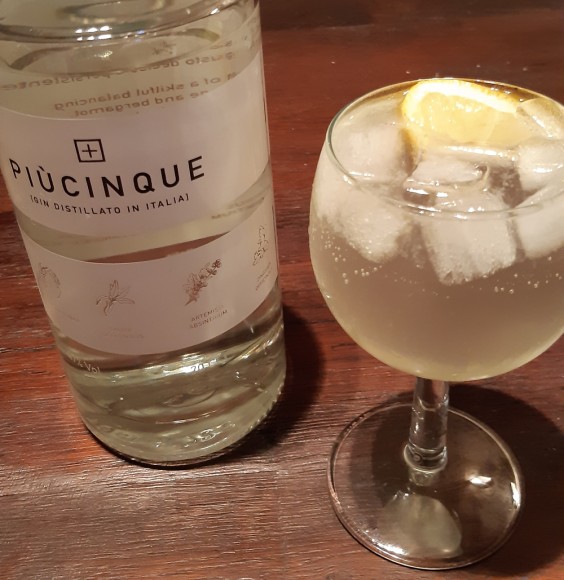
The Libellule
Ice cubes
1-1/2 ounces PiùCinque gin
Approximately 4 ounces ginger beer (Fever-Tree and its genuine ginger soul worked a treat)
Lemon slice, for garnish
1. Fill a highball or other glass (that fits the scene) three-quarters up with ice cubes. Add the gin, gently.
2. Add the ginger beer, and stir in a manner that’s not too wacky, but does combine well. Squeeze the lemon over and drop it in. Drink up, with a nod to Italy (unless you’re in Italy, in which case, just be happy you’re there).
Tags: cocktail, cocktail recipe, Dragonfly, Friday Night Cocktail, Gin, ginger beer, lemon, PiùCinque Gin, The Libellule, What I’m Drinking
Posted in: Gin, Italy, Recipes, What I'm Drinking
September 13, 2019
Ah well, all good things must pass – even the sunny days of summertime. The least we could do was have a drink to celebrate, and to do it right, the drink should probably have perhaps my favorite summertime treat in it (there are many! But this is tops), blackberries from the Lazy River Farm. This particular farm is not only home to the best blackberries in the world (big, fat, juicy at a level I’d never had before), but also home to Sidetrack Distillery, one of my all-time favorite distilleries anywhere. You should visit! Here, I use a bunch of blackberries to bring the flavor, then a few other friends to add a little of this (vodka), and that (Narancello, for a bit of orange), and that other (lemon, for the tang). It’s a nice treaty, and a good way to honor – and say so long to – summer.
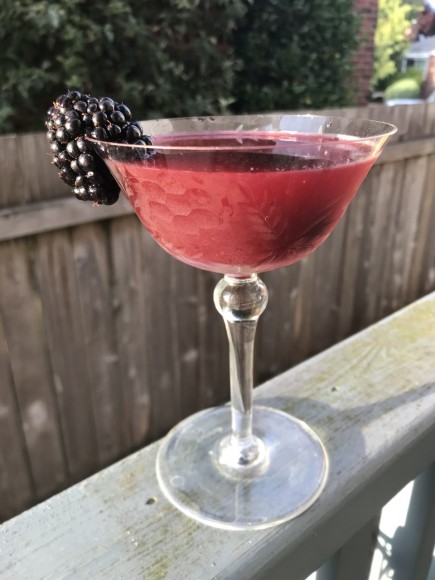 The End of Summer
The End of Summer
6 blackberries
Cracked ice
2 ounces vodka
1/2 ounce Narancello orange liqueur
1/4 ounce fresh lemon juice
Blackberry, for garnish
1. Add the first 6 blackberries to a cocktail shaker. Muddle well to just really get the juices flowing.
2. Fill the shaker halfway full with ice cubes. Add the vodka and lemon juice. Shake well.
3. Strain through a fine strainer into a cocktail glass. Garnish with the final blackberry.
Tags: blackberries, cocktail, Cocktail Recipes, Friday Night Cocktail, lemon, Narancello, orange liqueur, The End of Summer, vodka, What I’m Drinking
Posted in: Cocktail Recipes, Liqueurs, Recipes, vodka, What I'm Drinking
April 13, 2018
Wowsa, it’s been many a moon since I’ve had this charmer (which featured prominently along with 49 other beauts in Wine Cocktails). As you might expect from the title, it uses saké (which, admittedly, makes it an interesting fit in Wine Cocktails, but a delicious one, and those were interesting times, good times, for sure, but interesting if you know what I mean, and I’m sure you do). I like a slightly dry saké here, by the way, but really, most decent versions are gonna make a swell drink, a drink highlighted by the inclusion of coromandel gooseberry, better known as Star Fruit and also known as kamranga or five- finger fruit. All of which makes me want more names (A.J. Rathbun, better known as drinkaranga), and another one of these.
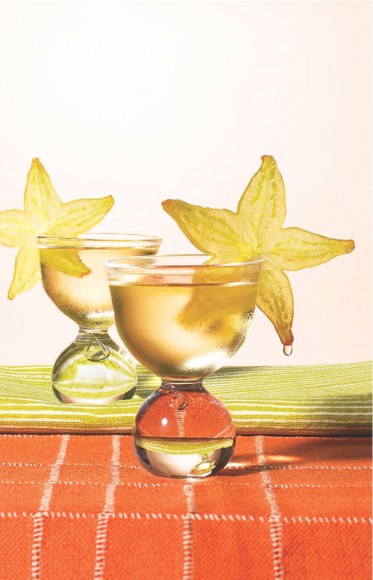
The Saké’d Saint
2 star fruit slices
1 lemon wheels
Ice cubes
1-1/2 ounces saké
1-1/2 ounces St-Germain liqueur
1/4 ounce apricot brandy
1. Add 1 star fruit slice and the lemon wheel to a cocktail shaker. Using a muddler, muddle well.
2. Fill the cocktail shaker halfway full with ice cubes. Add the saké, St-Germain, and apricot brandy. Shake extra well.
3. Strain through a fine strainer into a cocktail glass. Garnish with the second star fruit slice.
Tags: apricot brandy, cocktail, cocktails, Friday Night Cocktail, lemon, saké, St-Germain liqueur, star fruit, The Saké’d Saint, What I’m Drinking
Posted in: Cocktail Recipes, Liqueurs, Recipes, What I'm Drinking, Wine Cocktails
September 1, 2017
I recently was lucky enough to have a day where I could make the claim to luckiest person around (admittedly, I haven’t checked with every single person worldwide to test this particular proclamation, but hey, I still believe). On that day I was able to share the stage with my pal, genius novelist Andrew Sean Greer, and talk to him about his latest book LESS, while making him a few cocktails. LESS, if you don’t know, is the book of 2017, gaining raves from near and far – with people like Christopher Buckley saying in the NY Times, “Andrew Sean Greer’s Less is excellent company. It’s no less than bedazzling, bewitching and be-wonderful.” And they’re all well-deserved, because the book is charming, creative, funny, touching, and detailed in locations around the world with so much pizzazz that it’s a wonder Andy isn’t being hired by every city to write about their city. If that makes sense! Buy it now! Anyway, I’m rambling, as one does about great books, but to get back to the booze, for said lucky-day-for-A.J. I made up two drinks for Andy and I to sip while talking, naming both after characters in LESS. This first is named after the Italian translator of Less’ (oh, Arthur Less is the main character in the book, a novelist) latest book, and in honor of her and the Italian section of the book, contains all Italian ingredients.
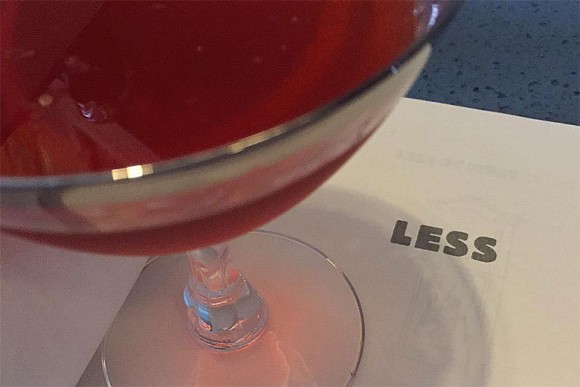
The Translation of Giuliana Monti
Cracked ice
1-1/2 ounces Purus organic Italian vodka
1 ounce Donini Dono di Dio aged vin santo
3/4 ounce Campari
Lemon twist, for garnish
1. Fill a cocktail shaker or mixing glass halfway full of cracked ice. Add everything but the twist. Stir well.
2. Strain into a cocktail glass. Garnish with the twist. Drink while reading LESS.
A Note: Donini Dono di Dio aged vin santo (vin santo being the “holy wine” of Italy, a lush dessert wine) is made by the fine folks at Donini winery, one of the finest in the universe, located in Verna, Italy, in my favorite area of Italy. If you can’t get it, I feel it’s time for you to take a vacation. Or, sub in another vin santo.
Tags: Andrew Sean Greer, Campari, cocktail recipe, Cocktail Recipes, Donini Dono di Dio aged vin santo, Friday Night Cocktail, lemon, LESS, Purus organic Italian vodka, The Translation of Giuliana Monti, vin santo, vodka, What I’m Drinking
Posted in: Campari, Cocktail Recipes, Italy, Recipes, vodka, What I'm Drinking




























